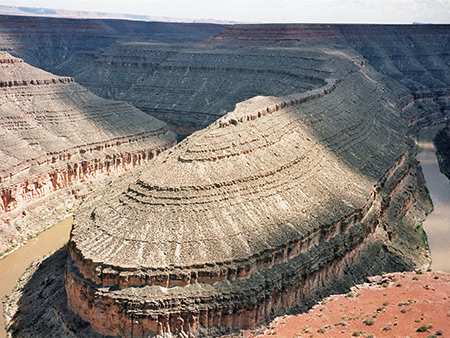Today at 12:51 PM Micaiah said this in Post #186
I'll concede to being rather dense, if that makes you happy, but I look for answers to my simple questions.
And people have given you answers to your questions and have repeated themselves so many times it feels like banging one's head against a wall.
Geologists use modern day calcium carbonate formation to indicate the formation of limestones such as the Redwall.
Creationists use volcanos and beach sands which have nothing to do with limestone at all. Gee, I wonder which one is more likely...

Are you afraid that such questions will further expose the soft underbelly of your theory?
LOL! What soft underbelly of our "theory"? We look at places where that type of rock forms and that indicates how the Redwall formed.
Your theory is the one with the soft underbelly--in fact it's nothing more than a falsified theory unless you care to address these following points:
1. The angular unconformity separating Precambrian from Paleozoic rocks.
2. The existence of metamorphic rocks and igneous intrusions.
3. The existence of basalts from the Cenozoic atop the Grand Canyon and in that vicinity (USGS:
target=_blank>http://wwwflag.wr.usgs.gov/GCSympos...ents_table.html)
4. The stratigraphy of the canyon itself. That is, a global flooding event taking place in 1 year or less cannot account for the stratigraphic distribution of well sorted sediments--not to mention the distinct layering of rock strata which are separated by erosional unconformities and also represent vastly different depositional environments.
5. The chemical rocks in the Grand Canyon (limestones) which would have had to have formed at an unheard of rate.
6. The paleontological data: the fact that we see organisms not only stratified by age, but we also see marine strata with exclusively marine organisms (brachiopods and crinoids that no longer exist today, for example) separated by strata that clearly have terrestrial flora and fauna in them. We also see this distinction by looking at trace fossils (e.g., footprints). This stratification by age and discontinuous representation of marine and terrestrial life are not explanable by your mechanism.
7. The goosenecks, or sharp meanders in the Colorado River, which Rufus indicated and illustrated with several pictures.
8. The fact that the river has eroded lithified rock as evidenced by deltaic deposits at the mouth of the river (and older deposits from when the river flowed in an opposite direction) and that the river has eroded through both metamorphic rock and igneous rock at the base of the canyon, which are crystalline rocks and obviously could not have been unconsolidated sediments, but rather very durable rock.
9. Radiometric age dating of igneous features of the Grand Canyon reveal dates far greater than a mere 6-12 thousand years before present.
10. The presence of paleosols (ancient soils) throughout several layers of the canyon including the Redwall limestone indicating that it was not formed underwater all at one time but rather exposed.
11. Collapsed caves/remnant karst topography.
12. The deposits from the outwash of the Colorado River indicate that it removed lithified rock.
Whatever ill-conceived argument you are trying to make about laminae is
entirely irrelavent in the face of these facts.



